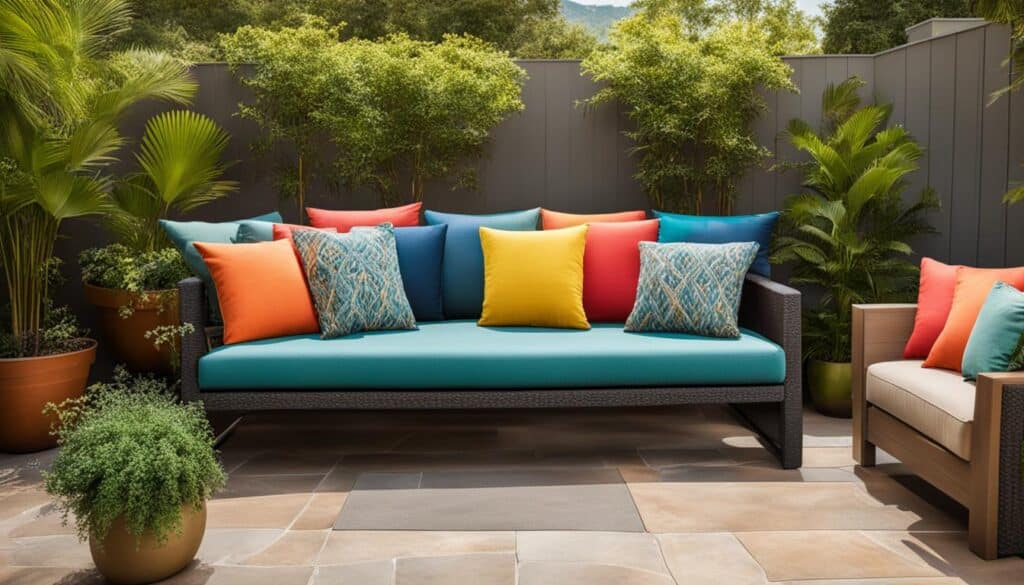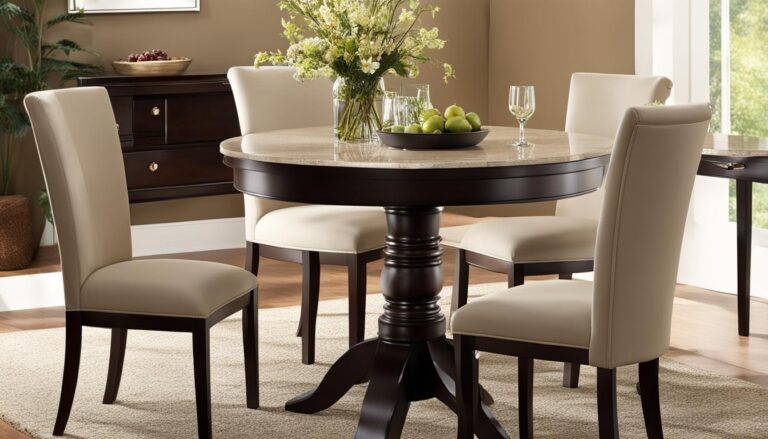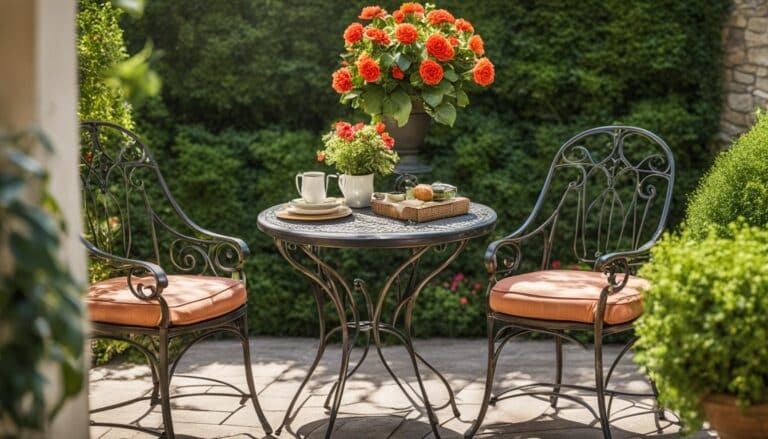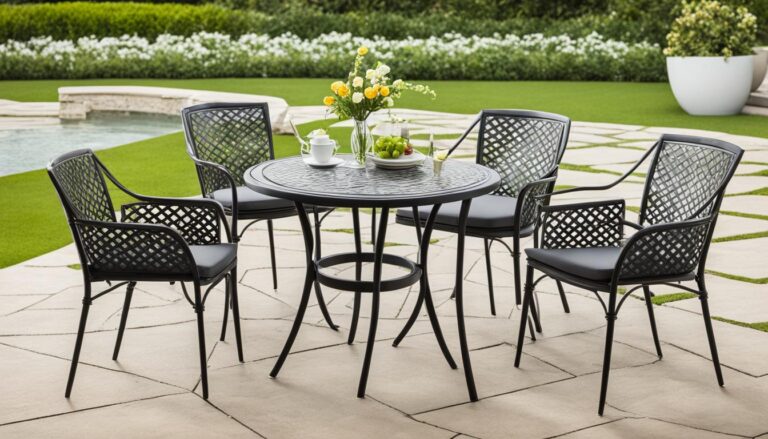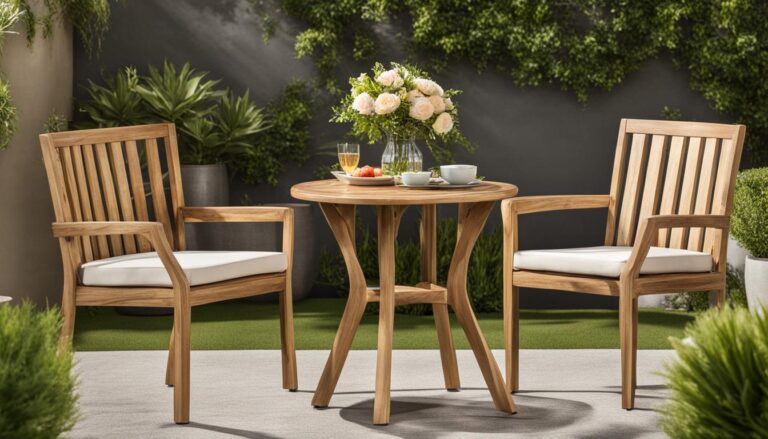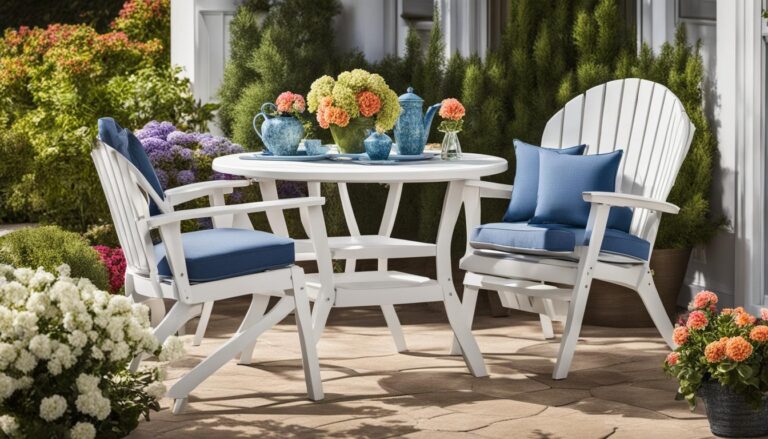One often overlooked way to outfit a beautiful exterior space is to bring pieces of old or unwanted indoor furniture outside. With the right treatment, you can repurpose a budget dresser into an ice chest, transform an old door into a bar, or turn a curbside find into an exterior storage bin. While interior furniture doesn’t last as long as outdoor pieces, you can get a lot of use out of a discarded indoor piece with the right treatment. Follow these simple steps to prep and paint your indoor furniture to make it suitable for outdoor use.
Key Takeaways:
- Repurposing indoor furniture for outdoor use allows you to add character to your space while making the most of what you already have.
- Properly prep, paint, and protect your furniture to ensure its longevity.
- Consider outdoor-friendly materials and weather-resistant fabrics when choosing indoor furniture for outdoor use.
- Regular cleaning and maintenance are essential for prolonging the life of your outdoor furniture.
- Using outdoor sealants and waterproofing sprays can provide extra protection against the elements.
Prepping Indoor Furniture
Before you can transform your indoor furniture into outdoor-ready pieces, it’s crucial to properly prep them. Follow these steps to ensure your furniture is clean, repaired, and ready for the transformation.
1. Clean: Start by thoroughly cleaning the furniture to remove any dust, dirt, or grime. Use a diluted solution of TSP or dish detergent and warm water to scrub the surfaces. Rinse thoroughly and allow the furniture to dry completely.
2. Repair: Inspect the furniture for any damage that needs attention. Repair loose corners, holes, or any other issues using wood putty and glue. Ensure all repairs are secure before proceeding.
3. Sand: After cleaning and repairing, lightly sand the surfaces of the furniture to create a better bond for the paint. Use a fine-grit sandpaper to gently sand the entire piece. Once sanded, clean off any residual sawdust before moving on to the next step.
These prepping steps are essential to ensure a smooth and durable finish for your outdoor furniture. Now that your furniture is prepped, you are ready to move on to the next step: painting.
Painting Indoor Furniture
Once you have prepped your indoor furniture, it’s time to choose the right paint for outdoor use. Look for a paint that is specifically formulated for exterior applications and suitable for furniture. A great option is Glidden® Trim, Door & Furniture paint, which provides excellent coverage and protection.
Before painting, ensure that you apply a coat of paint to every surface of the furniture that will be exposed to the elements. This includes the top, sides, and even the underneath of the piece. The goal is to encapsulate as much of the wood as possible for maximum protection against the outdoor elements.
After painting, allow the furniture to cure fully. The curing process may take several days to weeks, depending on the type of finish and humidity levels. Be patient and resist the urge to use the furniture until it is completely cured. This will ensure that the paint adheres properly and provides long-lasting durability.
Enhancing Your Painted Furniture
- To further enhance the appearance of your painted furniture, you can consider adding decorative trim or additional paint treatments. This will give your piece a unique and visually appealing look.
- Experiment with different painting techniques, such as distressing or stenciling, to add character and charm to your outdoor furniture.
- If you want to protect your furniture from wear and tear, consider applying a clear topcoat. This will provide an extra layer of protection and help maintain the beauty of your painted furniture over time.
By following these steps and selecting the right paint for outdoor use, you can transform your indoor furniture into beautiful, durable pieces that are suitable for outdoor spaces. Take the time to properly coat and cure your painted furniture, and don’t be afraid to add your own personal touch to enhance its appearance.

Using Outdoor Sealant and Waterproofing Sprays
If you have wooden furniture that you plan to use outdoors, it’s important to protect it from the elements. One way to do this is by using an outdoor sealant specifically designed for wood. The sealant creates a protective barrier that helps prevent moisture from seeping into the wood, reducing the risk of rot and decay.
When selecting an outdoor sealant, look for a clear option that won’t alter the natural beauty of the wood. Consider whether you prefer a glossy or matte finish based on your personal style. Applying the sealant is typically as simple as brushing or spraying it onto the wood surface, following the manufacturer’s instructions.
Additionally, if you have fabrics such as cushions or pillows that are exposed to the elements, consider using a waterproofing spray. These sprays create a protective barrier that repels water, helping to prevent moisture damage and mildew growth. Be sure to choose a waterproofing spray that is specifically designed for the type of fabric you are treating, and always follow the instructions provided on the product label.
Benefits of Using Outdoor Sealant and Waterproofing Sprays:
- Protection against moisture: Outdoor sealants help prevent moisture from penetrating the wood, reducing the risk of rot and decay.
- Extended lifespan: By protecting your furniture from the elements, you can extend its lifespan and prevent the need for premature replacement.
- Easy application: Outdoor sealants and waterproofing sprays are easy to apply, making it a convenient solution for protecting your furniture.
- Maintenance-friendly: Sealants and sprays can be reapplied as needed to maintain the protective barrier and keep your furniture looking its best.
By using outdoor sealant and waterproofing sprays on your furniture, you can ensure its durability and maintain its appearance for years to come. These simple steps will help prevent damage caused by exposure to sunlight, moisture, and temperature fluctuations, allowing you to enjoy your outdoor space without worrying about the condition of your furniture.
Choosing Weatherproof Materials and Fabrics
When it comes to transforming indoor furniture into outdoor-ready pieces, selecting the right materials and fabrics is crucial. By choosing weatherproof options, you can ensure that your furniture withstands the elements and remains in good condition for years to come.
Start by opting for outdoor-friendly materials such as aluminum, pressure-treated lumber, cedar, or redwood. These materials are known for their durability and resistance to weathering. They can withstand exposure to sunlight, moisture, and temperature fluctuations without deteriorating.
If you’re considering upholstered furniture, it’s important to choose fabrics that are specifically designed for outdoor use. Look for waterproof fabrics that are made to withstand the elements. Solution-dyed acrylic and Sunbrella are excellent choices as they are weather-resistant, fade-resistant, and easy to clean. These fabrics will maintain their color and texture even after prolonged exposure to sun and rain.
Benefits of Outdoor-Friendly Materials and Waterproof Fabrics:
- Enhanced durability and resistance to weathering
- Protection against sunlight, moisture, and temperature fluctuations
- Fade-resistant and easy-to-clean fabrics
- Long-lasting furniture for outdoor use
By prioritizing outdoor-friendly materials and waterproof fabrics, you can ensure that your repurposed indoor furniture remains in excellent condition and adds beauty to your outdoor space. Make the most of your existing pieces by selecting the right materials and fabrics that can withstand the demands of outdoor environments.
Conclusion
With a little creativity and some basic preparation, you can repurpose your indoor furniture to create stunning outdoor pieces. From transforming a dresser into an ice chest to turning an old door into a bar, the possibilities are endless. By following the steps outlined in this guide, you can give your furniture a new lease on life and add character to your outdoor space.
Repurposing indoor furniture for outdoor use not only allows you to save money but also gives you the opportunity to showcase your personal style. Whether you prefer a rustic look or a modern aesthetic, there are countless outdoor furniture ideas that can be brought to life with a little paint and imagination.
Remember to properly prep your furniture by cleaning, repairing, and sanding it before applying a suitable outdoor paint. Additionally, consider using an outdoor sealant to protect wooden pieces and waterproofing sprays to shield fabrics from moisture. These simple steps will help ensure the longevity of your outdoor furniture.
So, why spend a fortune on new outdoor furniture when you can repurpose your existing indoor pieces? Get creative, have fun, and transform your spaces with an outdoor furniture makeover that reflects your unique style.
FAQ
How do I prep indoor furniture for outdoor use?
Begin by cleaning the furniture and removing any grime using a diluted solution of TSP or dish detergent. Make necessary repairs using wood putty and glue if needed. Lightly sand the surface and clean off any residual sawdust.
What type of paint should I use for outdoor furniture?
Select a paint that is made for exterior use and suitable for furniture, such as Glidden® Trim, Door & Furniture. Apply a coat of paint to every surface that will be exposed to the elements for maximum protection.
How long does the paint need to cure on the furniture?
Allow the paint to cure fully, which may take several days to weeks, depending on the type of finish and humidity. Make sure the furniture is completely dry before using or adding any additional decoration.
How do I care for and maintain outdoor furniture?
Use outdoor furniture on covered porches or patios whenever possible to prolong its life. Regularly clean and wipe down the furniture, and protect cushions from rain. Consider recoating every few years or as needed.
How can I protect wooden furniture from the elements?
Use an outdoor sealant specifically designed for wood. Look for a clear sealant with a glossy or matte finish based on your preference. This will help protect the wood from sunlight, moisture, and temperature fluctuations.
Can I use waterproofing sprays on all outdoor fabrics?
Waterproofing sprays work best on washable fabrics such as outdoor cushions. Make sure to only use the spray on fabrics that can be washed, as it may not work on non-washable materials like leather.
What materials and fabrics are suitable for outdoor use?
Opt for outdoor-friendly materials such as aluminum, pressure-treated lumber, cedar, or redwood. For upholstery, choose fabrics specifically designed for outdoor use, like solution-dyed acrylic or Sunbrella, which are weather-resistant and won’t fade over time.
Can I transform indoor furniture into outdoor-ready pieces?
Yes, by following the steps mentioned and considering the materials and fabrics, you can repurpose indoor furniture for outdoor use. This allows you to add character to your space while making the most of what you already have.

